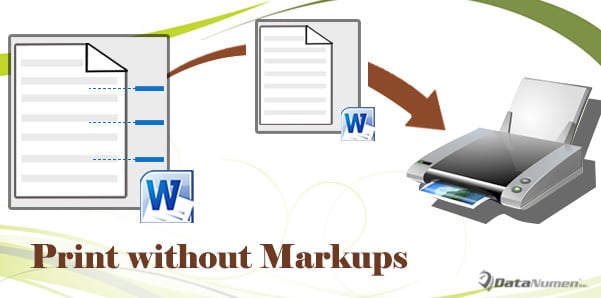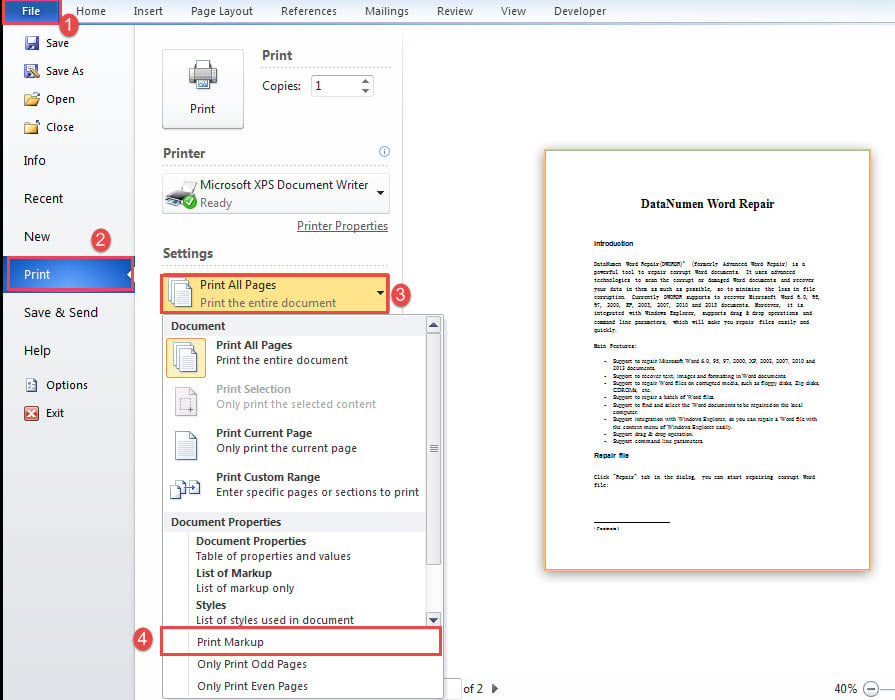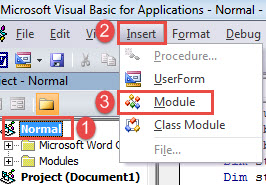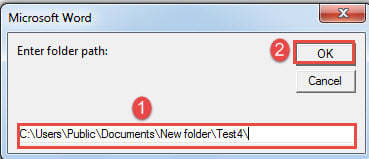In the coming article, we will focus on introducing you 3 quick ways to print your Word document without markups.
If your document requires revision, then you will definitely get all kinds of markups in your document. There are ways not to show them on screen. What about not to print them out?
The answer is positive. And our topic today is devoted to provide you with 3 quick and effectual methods to achieve the objective.
Method 1: Alter Print Options
- To begin with, click “File” tab in the Ribbon.
- Next click “Print” command.
- Then go to “Settings” section and click on the first drop-down box.
- On the menu, deselect “Print Markup” option. You will see markups nowhere on the right-side preview, which is the exact result you will get.
- Finally, choose printer and set other formatting and click “Print”.
Method 2: Use VBA Codes
In case you prefer auto processing, then running a macro is your top choice.
- First off, press “Alt+ F11” to trigger the VBA editor in Word.
- Then click “Normal”.
- Next click “Insert” tab and choose “Module” on its menu.
- Then double click to open the module and paste the following codes:
Sub PrintDocWithoutComments()
Application.PrintOut FileName:="", Range:=wdPrintAllDocument, Item:= _
wdPrintDocumentContent, Copies:=1, Pages:="", PageType:=wdPrintAllPages, _
Collate:=True, Background:=True, PrintToFile:=False, PrintZoomColumn:=0, _
PrintZoomRow:=0, PrintZoomPaperWidth:=0, PrintZoomPaperHeight:=0
End Sub
- Finally, click “Run”.
The code line “Copies:=1” sets the print copy at 1. You can change the copy number as required.
Method 3: Batch Print Multiple Documents without Markups
Now if you have a large number of files need to print without markups, the following macro will be your time saver.
- Firstly, put all target documents in the same folder.
- Then install and run macro following steps in method 2.
- Replace macro with this one:
Sub BatchPrintDocsWithoutComments()
Dim objDoc As Document
Dim strFile As String, strFolder As String
' Initialization
strFolder = InputBox("Enter folder path:")
strFile = Dir(strFolder & "*.docx", vbNormal)
While strFile <> ""
Set objDoc = Documents.Open(FileName:=strFolder & strFile)
Set objDoc = ActiveDocument
Application.PrintOut FileName:="", Range:=wdPrintAllDocument, Item:= _
wdPrintDocumentContent, Copies:=1, Pages:="", PageType:=wdPrintAllPages, _
Collate:=True, Background:=True, PrintToFile:=False, PrintZoomColumn:=0, _
PrintZoomRow:=0, PrintZoomPaperWidth:=0, PrintZoomPaperHeight:=0
objDoc.Save
objDoc.Close
strFile = Dir()
Wend
End Sub
- Now there is an input box. Enter the folder path where you store all target documents and click “OK”. Don’t forget the last “\” in the path string.
Cope with Document Corruption
Document corruption has been a frequently recurring theme. As a consequence, doc recovery has come up on the stage. There is a built-in function in Word helping you recover the broken files. Unfortunately, it doesn’t work well sometimes. Thus, you need a more eligible tool to do the job.
Author Introduction:
Vera Chen is a data recovery expert in DataNumen, Inc., which is the world leader in data recovery technologies, including Excel recovery and pdf repair software products. For more information visit www.datanumen.com



